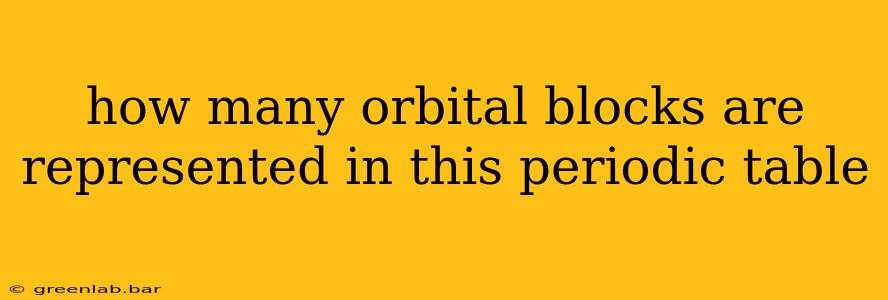How Many Orbital Blocks Are Represented in the Periodic Table?
The periodic table, a cornerstone of chemistry, organizes elements based on their atomic structure and properties. Understanding its structure reveals the answer to how many orbital blocks it represents. The short answer is four. Let's delve deeper into the specifics.
Understanding Electron Configuration and Orbital Blocks
The periodic table's organization is directly linked to the arrangement of electrons within an atom's electron shells. These electrons occupy specific orbitals, categorized into distinct blocks: s, p, d, and f. These blocks represent the type of atomic orbital that the outermost electrons occupy. The filling of these orbitals dictates the chemical properties and reactivity of each element.
The Four Orbital Blocks: A Detailed Look
-
s-block: This block encompasses Groups 1 (alkali metals) and 2 (alkaline earth metals), along with hydrogen and helium. The outermost electrons in s-block elements occupy the s orbital, which can hold a maximum of two electrons. This results in their characteristic properties, often involving the readily available single or two valence electrons.
-
p-block: Groups 13 through 18 belong to the p-block. Elements here have their outermost electrons in the p orbitals. p orbitals can hold up to six electrons, contributing to the diversity of properties seen within this large block. This block includes many nonmetals, metalloids (semi-metals), and some metals.
-
d-block: Transition metals are found in the d-block, typically spanning Groups 3 through 12. Their outermost electrons fill the d orbitals, which can accommodate up to ten electrons. This electron configuration explains the varied oxidation states and complex ion formation commonly observed in transition metals.
-
f-block: Situated below the main body of the periodic table, the f-block elements are the lanthanides (rare earth elements) and actinides. Their outermost electrons occupy the f orbitals, capable of holding up to fourteen electrons. This results in their unique chemical behavior and the similarities observed within each series.
Beyond the Four Blocks: Future Possibilities?
While the current periodic table neatly organizes elements into these four orbital blocks (s, p, d, and f), the theoretical possibility of g-block elements exists. These hypothetical elements would have electrons occupying the g orbitals, which could hold up to eighteen electrons. However, the synthesis and observation of such elements are currently beyond our technological capabilities. Their existence remains purely theoretical at this point.
Conclusion
In summary, the periodic table, as we know it, effectively represents four orbital blocks: s, p, d, and f. These blocks reflect the underlying atomic structure and are fundamental to understanding the properties and behaviors of the elements. While theoretical expansion into a g-block is possible, it remains firmly in the realm of speculation.

